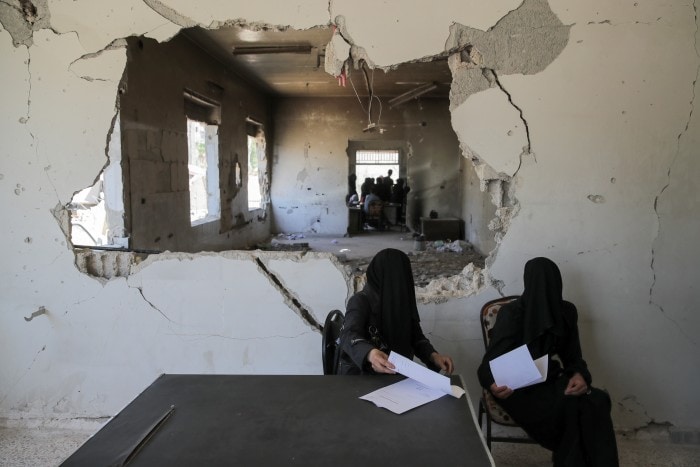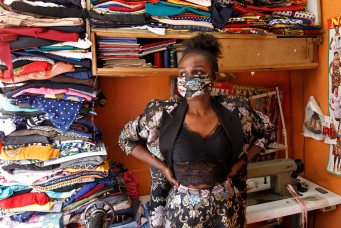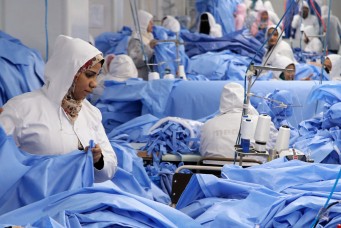Let Conflicts Be Bygones
A sobering look at how COVID-19 will affect Libya, Syria, and Yemen, where war and conflict have not only decimated most of these countries’ precious resources but are further destroying what remains of them.

When the Spanish flu arrived at the doorsteps of the Persian city of Mashhad in August 1918, the worst was yet to come. A pawn in the Great Game between the Russians and the British, Persia functioned more or less like a failed state, was bankrupt, and ravaged by years of war. Mashhad was a hub of Shia pilgrimage and an important supply route for the White Russian and British armies. Within a fortnight, two-thirds of the city’s population fell sick and eventually the mortality rate climbed significantly higher than any other country or region, affecting between 8 and 22 percent of the population. By way of comparison, the global average was estimated to be greater than 2.5 percent and, in the United States, it reached a mere 0.6 percent.
Although the viral spread of the disease accounted for the high number of fatalities, unpreparedness in dealing with a pandemic was seen to be a major contributing factor. Amir Afkhami wrote in the Bulletin of the History of Medicine that the “horsemen of the apocalypse” were war, famine, and pestilence. Already before the arrival of the Spanish flu, Iranians were grappling with a typhus epidemic and a terrible famine alongside years of war that had debilitated the health infrastructure of the country. And notwithstanding that variants of “social distancing” measures such as quarantine zones and isolation wards were being implemented in other parts of the world, the government in Iran was not ready or able to decree any of these practices.
Parallels may be seen in conflict-ridden countries of the Middle East today. Syria, Yemen, and Libya in particular were still reeling from the blows of war or civil conflict when the COVID-19 flu hit. They will certainly be the most affected when the pandemic does its worst. But are governments, parties, and non-state actors who govern these countries prepared to cope with what is to come? And in what ways will the pandemic intensify the conflicts in those areas?
Syria: Sicker Divided
In Syria, the situation is dire, and wounds of war are still grossly fresh. Officially, there are thus far forty-three confirmed cases in Syria and three deaths. A widely shared London School of Economics report found that due to its devastated resources, in which a little over half of the healthcare facilities are functioning and only 30 percent of health workers are available to work, the country is only equipped to deal with 6,500 cases. If Syria were to cross this threshold, “the healthcare system is likely to collapse … and the overall mortality rate likely to increase by at least an additional 5 percentage points among infected people,” the report reads.
While countries have used and expanded their surveillance to track cases of COVID-19, in Syria the government is managing the crisis as if it were a security threat, leaving the security apparatus to run and monitor the official healthcare response. Mazen Gharibah, one of the co-authors of the LSE report, told Syria Untold that people would hide symptoms or not go to hospitals for fear of being interrogated or questioned. There are advertisements asking people to report people who have symptoms similar to COVID-19.
Apart from these cases that go undocumented, it is generally hard to put an exact figure on the number of cases in Syria or how they are being dealt with, especially as the country is divided into three separately governed regions that do not interact with one another. For example, the opposition-held northwest and the Kurdish-controlled northeast—the two areas still outside of Bashar Al-Assad’s control—each have their own set of issues as a result of the political divisions created by the war. Some areas have a refugee problem because of internal displacement as a result of the fighting or face resource marginalization if they are allied with the wrong side.
Making matters worse, armed conflict has not died down in recent weeks. In the northwest, Idlib and northern Aleppo, for example, have been the site of a recent military escalation of the Syrian army and Russian allies to retake the province from the opposition. As a result, almost one million Syrians have been displaced since December of last year, the large majority of which are living in crowded camps near the Turkish border.
“Several tents will have to share latrines. Water is not always available for people to have the luxury of washing their hands,” said Yazan Douedari, a research assistant at the London School of Hygiene and Tropical Medicine. “It’s very concerning that when the virus reaches these camps, the spread could be much faster than what we witnessed globally.” Although widespread testing has been reported in the northwest, the region is generally isolated (Turkey closed its border with Syria and the borders around its enclave within Syria), and fighting has put sixty-two medical facilities out of action over the past year. In case of an outbreak, all these factors combined would pose a dangerous risk to the already existing humanitarian catastrophe.
But even more dangerous is that fighting has been essentially put on hold due in large part to Turkey’s intervention to de-escalate Russia’s military campaign in the northwest. In a series of tit-for-tat strategic moves, Turkey, through a mix of military craft and diplomatic maneuvering, was able to get Russia to slow down from its offensive in Idlib. They both ended up signing an agreement on March 5 agreeing to a ceasefire, a seven-mile safe corridor, and a joint patrolling of the area. However, how long this halt of hostilities will last and what the outcome and logic will be behind this political game, especially one that is played by parties who do not see eye to eye and do not presume to be allies, is unclear for now.
The condition is far worse in the northeast—a casualty of the political situation due to ongoing disputes between Turkish-led groups and the SDF administration—where the region has been left with only one fully functional hospital. Availability of testing is particularly problematic; a contentious Security Council vote on Resolution 2449 put an end to a cross-border aid mechanism across a couple of borders in Syria, meaning that the northeast region effectively became out of the reach of UN assistance.
Furthermore, the political leverage of the regime has affected access to aid organizations and services. Maha Yahya, director of the Carnegie Middle East Center, wrote, “The World Health Organization is operating only in regime-held areas, in spite of calls urging them to provide more support to northeastern and northwestern Syria. At the same time, the central government in Syria has refused to set up coronavirus testing facilities in opposition-held areas and only recently agreed to set up a lab in the government-controlled part of Qamishli.” Tests for suspected cases within SDF territory were initially transported to Turkey.
In its own response, the Syrian regime temporarily suspended mandatory conscription, cordoned off two towns, and set up quarantine zones with the help of the WHO. Additionally, it closed down public transport, established night and weekend curfews, and banned internal movement between its governorates.
Paradoxically, as the three regions are closed off from one another, it is possible that the movement of fighters from Iran has been the cause of the virus spreading in the first place. Douedari said that fighters who travel between Iran and regime-controlled areas in Syria number in the thousands—Israel’s ambassador to the UN claimed there were eighty thousand Iranian fighters in Syria in 2018—and with the virus widespread in Iran, “from a statistical point of view, it’s very likely that the virus spread to Syria very early on via these fighters and it continued to spread through the population unmonitored and undocumented.”
Syria’s fragmentation and unfinished warfare impede a proper response to the pandemic, apart from a destroyed public health system as a result of nine years of war. It is very possible that Syria’s fragmentation will make its people sicker.
A Yemen That Won’t Stop Fighting
Almost as soon as a ceasefire was announced in Yemen on April 9, it was violated: the Houthis attacked the eastern governorates of Al-Jawf, Marib, and Al-Bydaa, leading to military confrontations with government forces. At the other end of the country, clashes broke out between the United Arab Emirates-backed Southern Transitional Council (STC) and some factions supported by Saudi Arabia, and in the south, tensions escalated between the Saudi-backed forces and the STC fighters in Abyan and Aden.
The Houthis also launched two ballistic missile at Saudi Arabia, including one at Riyadh, marking the first Houthi attack inside the kingdom since September 2019. Saudi air defenses intercepted the strikes and countered them with airstrikes in Sanaa.
“The problem is that almost all the warring parties think that it is an incomplete war for them,” said Ahmed Nagi, a nonresident scholar at the Carnegie Middle East Center in Beirut. “They are not convinced that they have to stop the war at this point. They feel that—to some extent—they still have cards to play on the ground before using them at the negotiating table.”
However, it is not just the fighting that puts Yemen at risk during a pandemic, but that some of its players bite the hands of those who offer to help. The Houthis, for example, have placed conditions on international NGOs and UN organizations to impede the delivery of humanitarian aid to the areas they control, including denying access to aid, diverting aid to their beneficiaries, and even selecting the employees of humanitarian organizations. As a result, the World Food Programme decided to cut aid by half in Houthi-controlled areas starting mid-April and USAID partially suspended its operations. This is disastrous given that up to ten million Yemenis, including millions of malnourished children, are one step away from famine.
Over the years, Yemen has developed its own internal borders that are controlled by the warring parties. Apart from the blockading of air and seaports by the Saudi-led coalition, restricting the movement of people and goods between different parts of the country can be detrimental in case of an outbreak as Yemenis might be denied access to necessary healthcare or fined if they crossed these made-up borders. “Every warring party is dealing with its respective area like it’s an independent country or territory,” Nagi said. This probably explains why there is only one confirmed coronavirus case in Yemen’s Hadramout province. Each area took its own precautionary measures and has its own rules of transparency.
If the cholera outbreak of the past three years has taught Yemenis anything, it is that they cannot trust those in power. The cholera epidemic that started in 2017 affected one million people and caused thousands of deaths. But parties to the conflict took to the battlefield anyway. “What we learned is that there is a big gap between the warring parties’ interests and civilians’ concerns. So, we have conflicting parties who are giving zero concern about the humanitarian situation,” Nagi continued. And when it comes to COVID-19, Houthi activists and militiamen utilized the pandemic as an opportunity to recruit among their ranks and make calls for martyrdom, declaring the “battlefield the safest place from the coronavirus”. Health experts agree that for Yemen to even consider giving itself a proper chance to survive COVID-19, it must stop the fighting.
A Fast-Changing Libya
In a recent twist of events, the balance of power in Libya has been shifting. In the past week, less than a month after a March 21 truce was announced to deal with COVID-19, forces allied with the UN-recognized Government of National Accord (GNA) made advances in western Libya, capturing territory controlled by Khalifa Haftarand the Libyan National Army (LNA) and pushing toward Haftar’s last-remaining bastion in Tarhouna, sixty-five kilometers from the capital. This marks a possible turning point since Haftar launched an offensive in April of last year to capture Tripoli and dethrone the seat of the GNA.
However, the shifting balance of military power does not necessarily translate into a political one. It was the intervention of Turkey on the side of the GNA—supplying advanced weaponry and drones, sending foreign fighters/mercenaries, and even deploying their navy assets and frigates—that was able to turn the tide of the war. “The worrying part here is that the countries that support the LNA have invested so much militarily, financially, and politically and it is difficult to see how they will give up on this. If the Turks doubled down, I expect them to quadruple down to push even more,” said Mohamed Eljarh, cofounder and CEO of Tobruk-based LORC Research and Consultancy. Not only does this mean that there are a number of possible political outcomes, but it also carries huge risks for Libyans, in terms of deteriorating living conditions, hiking food prices, the plummeting exchange rate of the Libyan dinar, and near-zero oil production.
If the LNA, which is supported by the UAE and Egypt, strikes back, then it could be in one of two ways, Eljarh projects. Either there is a coordinated attack with Russia or the UAE and Egypt conduct airstrikes. Another, albeit slim, possibility in the case that Haftar admits defeat and Turkey makes sure to secure its interests, is that a settlement of sorts be reached.
However, the heaviest toll amid this political and armed fighting will be among civilians. Although Libyan authorities were quick to take precautionary measures early on such as enforcing partial curfews and shutting down public institutions, the recent intensification of violence in Tripoli, for example, has internally displaced many people. As a result, Tripoli went one week without water or electricity and shelling ensued on some medical facilities. This is separate from another two hundred thousand displaced Libyans elsewhere in the country who are living in horrible conditions. “If there was an outbreak, I doubt that Libya will be able in any shape or form to respond to that,” Eljarh said, “I think what we will end up with is possibly chaos and panic more than anything; chaos and panic amongst civilians but also chaos and panic amongst health and medical workers” who might refuse to go to the hospitals to treat people. Already the public health system was further weakened during and after April 19, when Haftar tried to take over Tripoli and targeted many hospitals and medical facilities. Moreover, testing is extremely limited in Libya, which most likely puts the sixty positive cases of COVID-19 and two deaths at a much higher number. How these and other patients will be treated without a viable healthcare infrastructure and system is problematic.
Similar to other conflict countries suffering from de facto partition, in Libya, there are two rival administrations that are running different response plans to COVID-19. This has caused for there to be disparities in the measures taken in the eastern and western parts of Libya. In Tripoli, in the western part of the country, for example, the authorities decided to introduce a full curfew after fourteen cases were discovered in one day, a measure that was not enforced in the other side of the country. But when that happened, it set off scenes of chaos, said Eljarh. “We saw scenes of people crowding up outside shops with thousands if not maybe even millions of people trying to get their food in before [the start of the curfew].” However, one of the biggest problems, Eljarh added, is that both administrations at the end of the day are at war and so, “you can imagine in Tripoli in particular you have a government that is trying to respond to this issue but at the same time it is a government that is at war. And most of the efforts of both sides are directed at fighting each other.”
However, Frederic Wehrey, a senior fellow in the Middle East Program at the Carnegie Endowment for International Peace, wrote that both administrations do not exert much authority over Libya’s hyperfragmented towns and regions. “In these areas, a hybrid governance holds sway, comprising local town councils, kin groups, and armed groups (which enjoy community support in some areas).” That has translated locally into public health, sterilization, and awareness campaigns on the grassroots and communal level, which could open up or introduce a new model of local governance in Libya.
If the 1918 Spanish flu outbreak in Iran serves as a history lesson, it is wise to set aside differences in times of war to avoid history repeating itself. However, whether that can be done and whether war damages can be mended is a lesson that still remains to be seen.
Nadeen Shaker is senior editor at the Cairo Review of Global Affairs. She has contributed to Vice News, Le Monde Diplomatique, Kerning Cultures, the Middle East Report, Mada Masr, The Postcolonialist, and elsewhere. On Twitter: @NadeenShaker.
Read More



